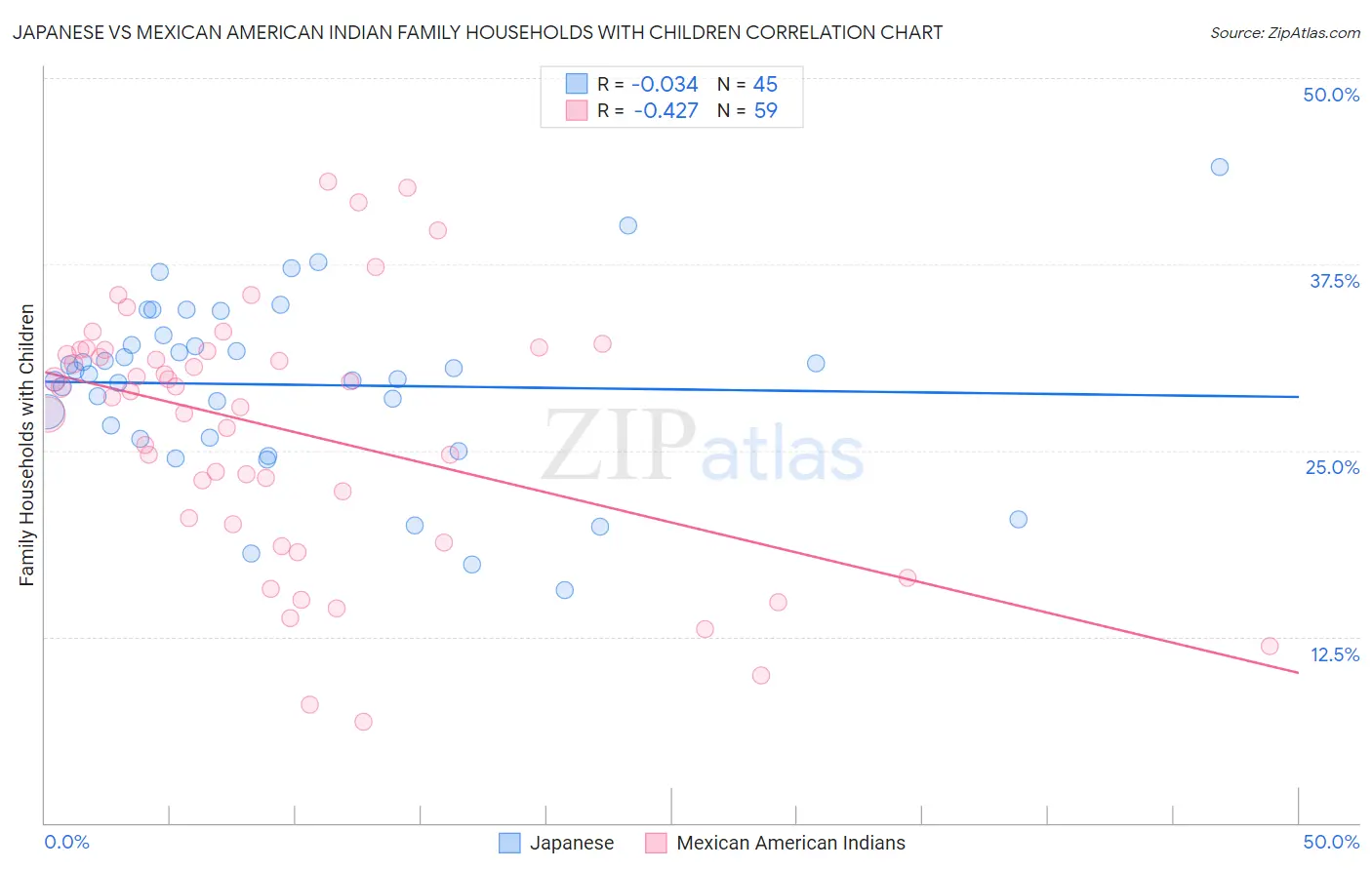Japanese vs Mexican American Indian Family Households with Children
COMPARE
Japanese
Mexican American Indian
Family Households with Children
Family Households with Children Comparison
Japanese
Mexican American Indians
29.4%
FAMILY HOUSEHOLDS WITH CHILDREN
100.0/ 100
METRIC RATING
31st/ 347
METRIC RANK
29.7%
FAMILY HOUSEHOLDS WITH CHILDREN
100.0/ 100
METRIC RATING
23rd/ 347
METRIC RANK
Japanese vs Mexican American Indian Family Households with Children Correlation Chart
The statistical analysis conducted on geographies consisting of 249,052,059 people shows no correlation between the proportion of Japanese and percentage of family households with children in the United States with a correlation coefficient (R) of -0.034 and weighted average of 29.4%. Similarly, the statistical analysis conducted on geographies consisting of 317,453,959 people shows a moderate negative correlation between the proportion of Mexican American Indians and percentage of family households with children in the United States with a correlation coefficient (R) of -0.427 and weighted average of 29.7%, a difference of 1.0%.

Family Households with Children Correlation Summary
| Measurement | Japanese | Mexican American Indian |
| Minimum | 15.6% | 6.8% |
| Maximum | 44.0% | 43.0% |
| Range | 28.4% | 36.2% |
| Mean | 29.4% | 26.3% |
| Median | 30.1% | 29.0% |
| Interquartile 25% (IQ1) | 25.8% | 20.1% |
| Interquartile 75% (IQ3) | 32.4% | 31.7% |
| Interquartile Range (IQR) | 6.6% | 11.7% |
| Standard Deviation (Sample) | 5.9% | 8.6% |
| Standard Deviation (Population) | 5.9% | 8.5% |
Demographics Similar to Japanese and Mexican American Indians by Family Households with Children
In terms of family households with children, the demographic groups most similar to Japanese are Immigrants from Yemen (29.4%, a difference of 0.060%), Yuman (29.5%, a difference of 0.14%), Samoan (29.5%, a difference of 0.18%), Bolivian (29.5%, a difference of 0.18%), and Venezuelan (29.4%, a difference of 0.26%). Similarly, the demographic groups most similar to Mexican American Indians are Guamanian/Chamorro (29.7%, a difference of 0.10%), Immigrants from Latin America (29.7%, a difference of 0.20%), Malaysian (29.8%, a difference of 0.27%), Immigrants from Laos (29.8%, a difference of 0.31%), and Immigrants from El Salvador (29.8%, a difference of 0.35%).
| Demographics | Rating | Rank | Family Households with Children |
| Hispanics or Latinos | 100.0 /100 | #17 | Exceptional 29.9% |
| Salvadorans | 100.0 /100 | #18 | Exceptional 29.9% |
| Alaska Natives | 100.0 /100 | #19 | Exceptional 29.9% |
| Immigrants | El Salvador | 100.0 /100 | #20 | Exceptional 29.8% |
| Immigrants | Laos | 100.0 /100 | #21 | Exceptional 29.8% |
| Malaysians | 100.0 /100 | #22 | Exceptional 29.8% |
| Mexican American Indians | 100.0 /100 | #23 | Exceptional 29.7% |
| Guamanians/Chamorros | 100.0 /100 | #24 | Exceptional 29.7% |
| Immigrants | Latin America | 100.0 /100 | #25 | Exceptional 29.7% |
| Sri Lankans | 100.0 /100 | #26 | Exceptional 29.5% |
| Immigrants | Vietnam | 100.0 /100 | #27 | Exceptional 29.5% |
| Samoans | 100.0 /100 | #28 | Exceptional 29.5% |
| Bolivians | 100.0 /100 | #29 | Exceptional 29.5% |
| Yuman | 100.0 /100 | #30 | Exceptional 29.5% |
| Japanese | 100.0 /100 | #31 | Exceptional 29.4% |
| Immigrants | Yemen | 100.0 /100 | #32 | Exceptional 29.4% |
| Venezuelans | 100.0 /100 | #33 | Exceptional 29.4% |
| Immigrants | Bolivia | 100.0 /100 | #34 | Exceptional 29.3% |
| Immigrants | Sierra Leone | 100.0 /100 | #35 | Exceptional 29.3% |
| Immigrants | Venezuela | 100.0 /100 | #36 | Exceptional 29.3% |
| Immigrants | Cameroon | 100.0 /100 | #37 | Exceptional 29.2% |